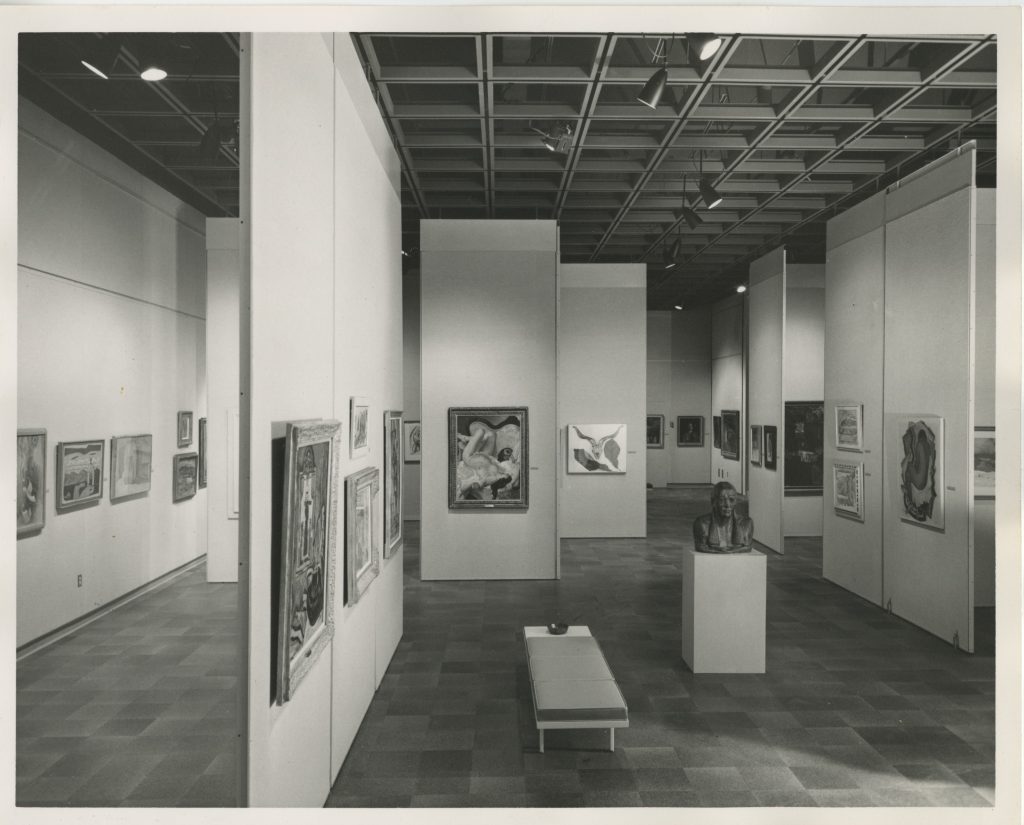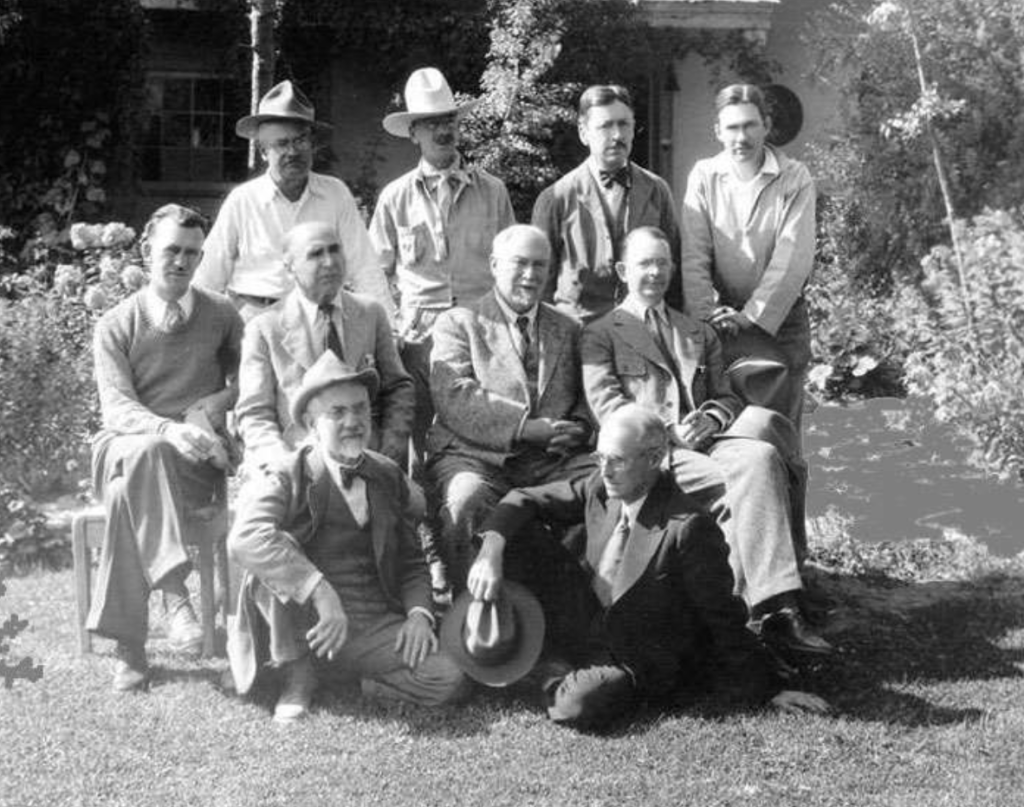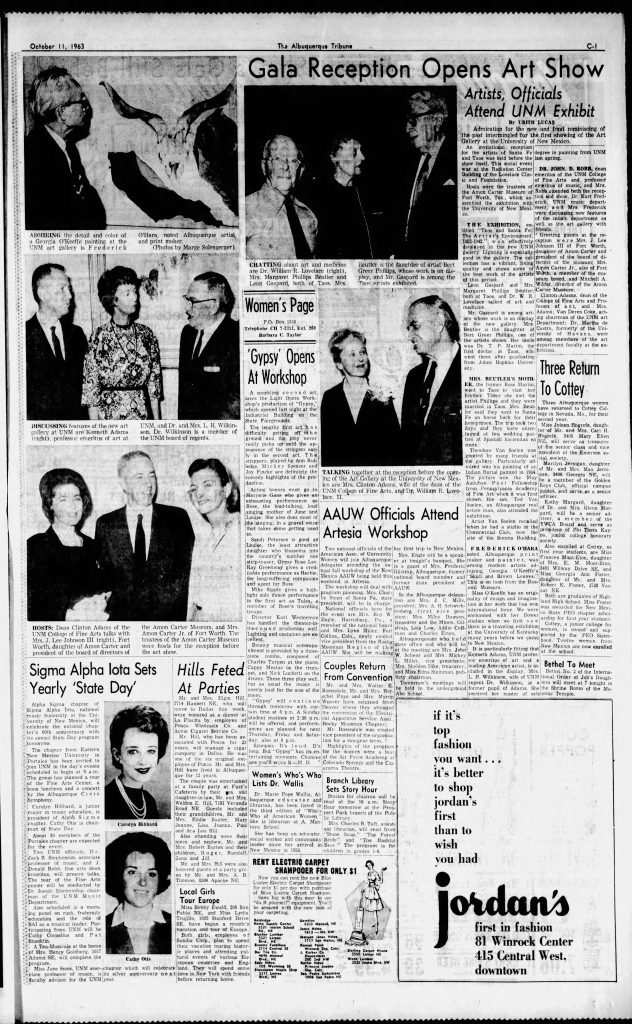FROM THE ARCHIVES: “Taos and Santa Fe: The Artist’s Environment, 1882 -1942”
Written by Hannah Cerne, UNMAM Research Assistant

Figure 1. Install photograph of Taos and Santa Fe at the University Art Gallery (now known as the UNM Art Museum.) From the UNMAM Archives, October 10, 1963.
The University Art Gallery (now known as the University of New Mexico Art Museum) was founded in 1963. The first exhibition on display at the art museum was titled, Taos and Santa Fe: The Artist’s Environment, 1882 –1942, curated by Clara Grotta. The traveling exhibit was on view from September to October in 1963. The exhibition (Figure 1) featured artists north of the Rio Grande Valley, in areas such as Taos and Santa Fe, New Mexico.
Although not displayed until 1963, museum staff jointly prepared the Taos and Santa Fe exhibition with the Amon Carter Museum of Western Art (now known as the Amon Carter Museum of American Art) in 1962. The traveling exhibition was first on view at the Amon Carter Museum of American Art from mid-April through June of 1963. (Fig. 2). The exhibition then traveled to La Jolla Art Center in La Jolla, California before making its way to the University of New Mexico Art Museum. The exhibition featured paintings and drawings of beautiful New Mexican landscapes and Indigenous communities and cultures. A few of the most prominent works from the exhibition include Raymond Jonson’s, Cloud Forms and Mesas No. 1 (1926), Cady Wells, New Mexico Landscape (1940), and Oscar E. Berninghaus, Pueblo Indian Women of Taos (c. 1925).

Many of the artists involved in the exhibition were members of the Taos Society of Artists and the Santa Fe Art Colony. Founded in the early 1900s, the purpose of these societies was to connect new artists in the areas and provide them with support, promotion of shows, exhibition information, and more. Although both societies were prosperous in members and visitors, it was the members of the Taos Society of Artists that gained prevalence across the country. The Taos Society of Artists exhibited their work across prominent museums and galleries in the United States including the Howard Young Galleries in New York, NY and the Fine Arts Museum of New Mexico in Santa Fe, NM.
Figure 2. An informal invitation to the exhibition at the Amon Carter Museum of Western Art, from the UNMAM Archives.

Figure 3. Back row: Ufer, Dunton, Higgins, Adams. Seated: Hennings, Phillips, Couse, Berninghaus. Front row: Sharp; Blumenschein. Taos Society of Artists – Course-Sharp Historic Site (1932)
The members involved with the Taos and Santa Fe: The Artist’s Environment, 1882 -1942 included the founders of the Taos Society of Artists, Joseph H. Sharp, E.L. Blumenschein, Bert G. Phillips, E. Irving Couse, Oscar E. Berninghaus, and Herbert Dunton, known as the “Taos Six.” (Fig. 3). The Taos Society of Artists grew quickly in members, by 1927 the group had 12 active artists. The first female member of the Taos Society of Artists, Catherine C. Critcher, joined in 1924. Critcher opened the door for other female artists such as Mabel Dodge Luhan to become a member and eventual leader of the Taos Society of Artists. The Taos Society of Artists and Santa Fe Art Colony members had one thing in common, they all moved to the Southwest to find gorgeous mountain views, graceful skies, and a relationship with nature unlike anything they had experienced.
The Taos and Santa Fe: The Artist’s Environment, 1882 -1942 was shared with the public through local newspapers, such as the New Mexico Lobo, now known as the Daily Lobo and The Albuquerque Tribune, now known as the Albuquerque Journal. The exhibition was received well by the public of Albuquerque, NM. Urith Lucas, a reporter at The Albuquerque Tribune wrote a review on October 11, 1963, stating, “Lighting is especially good in the gallery. The collections have a vibrant, living quality and shows some of the best work of the artists of this period.” (Fig. 4).

Figure 4. The review of the exhibition in The Albuquerque Tribune, Friday, October 11, 1963.
The success of the first year of the UNM Art Museum was recorded in the 1963-64 annual report, stating “…the gallery presented a series of events which attracted enthusiastic response from the entire community. The effect of the gallery program as a stimulus to student work in art was seen immediately, particularly at the graduate level.” After a prosperous first year at the UNM Art Museum, there was motivation to expand the collection and future exhibitions.
By the early 1920’s Raymond Jonson was one of the many artists who moved to the Taos and Santa Fe areas. Jonson’s involvement as an artist in Taos and Santa Fe: The Artist’s Environment, 1882 -1942 displayed his wide range of talents as an artist, professor, and mentor to the community. Taos and Santa Fe showcased a curated group of experts in their craft and provided an unforgettable exhibition for the people of the Southwest. Jonson’s involvement with the art colonies provided new connections through his work inside and outside of his studio. Jonson taught at the University of New Mexico (UNM) for twenty years, where he was a professor, curator, and mentor. By 1949 UNM announced the opening of the Jonson Gallery. Retiring from UNM in 1954, Jonson continued to curate, mentor and volunteer for the students and the University. In 1956 Raymond Jonson and Ted Egri held an exhibition in the Jonson Gallery that highlighted the new artists in Taos. This group and exhibition were given the title, Taos Modernists by Jonson and Egri. The exhibition title had a profound effect on the Taos Society of Artists, their title for the art colony was quickly changed to Taos Modernists. Jonson and Egri revolutionized the Taos Society of Artists, now known as the Taos Modernists or Taos Moderns.
Jonson’s considerable effect on the University of New Mexico and the UNM Art Museum still resonates today. The UNM Art Museum celebrates Jonson currently by exhibiting his work in the lower gallery, also referred to as the Jonson Gallery. The exhibition is titled, Pelton & Jonson: The Transcendent 1930s, and will be on display throughout the 2023 fall semester. The exhibition features the work of Agnes Pelton, Raymond Jonson, and Cady Wells.
The exhibitions and collections the museum presents for the benefit of the students, researchers, and community create an experimental environment for all to feel welcome. Taos and Santa Fe: The Artist’s Environment, 1882 -1942 initiated the momentum for the UNM Art Museums mission to educate the University students and connect the community through creativity and art.
